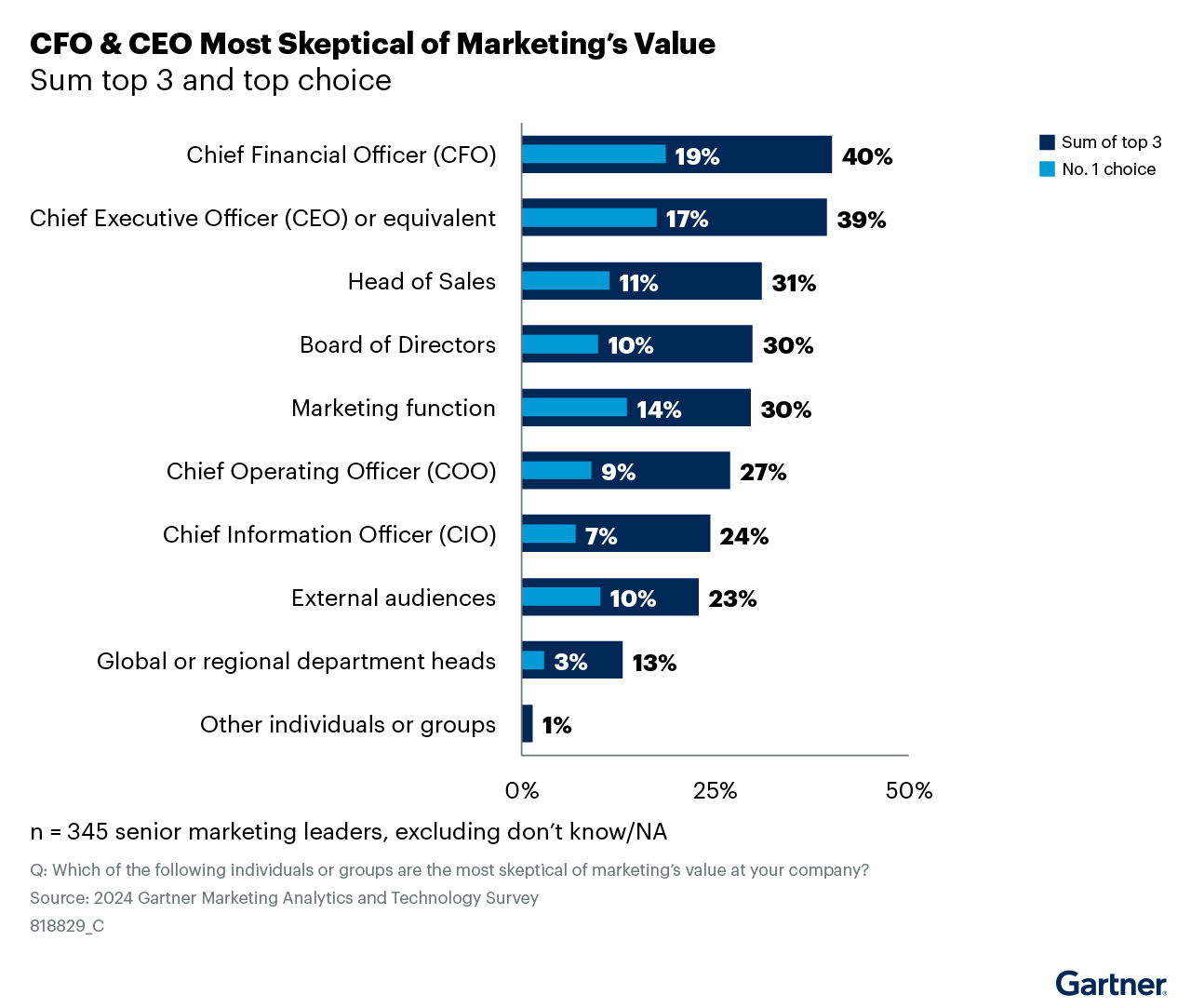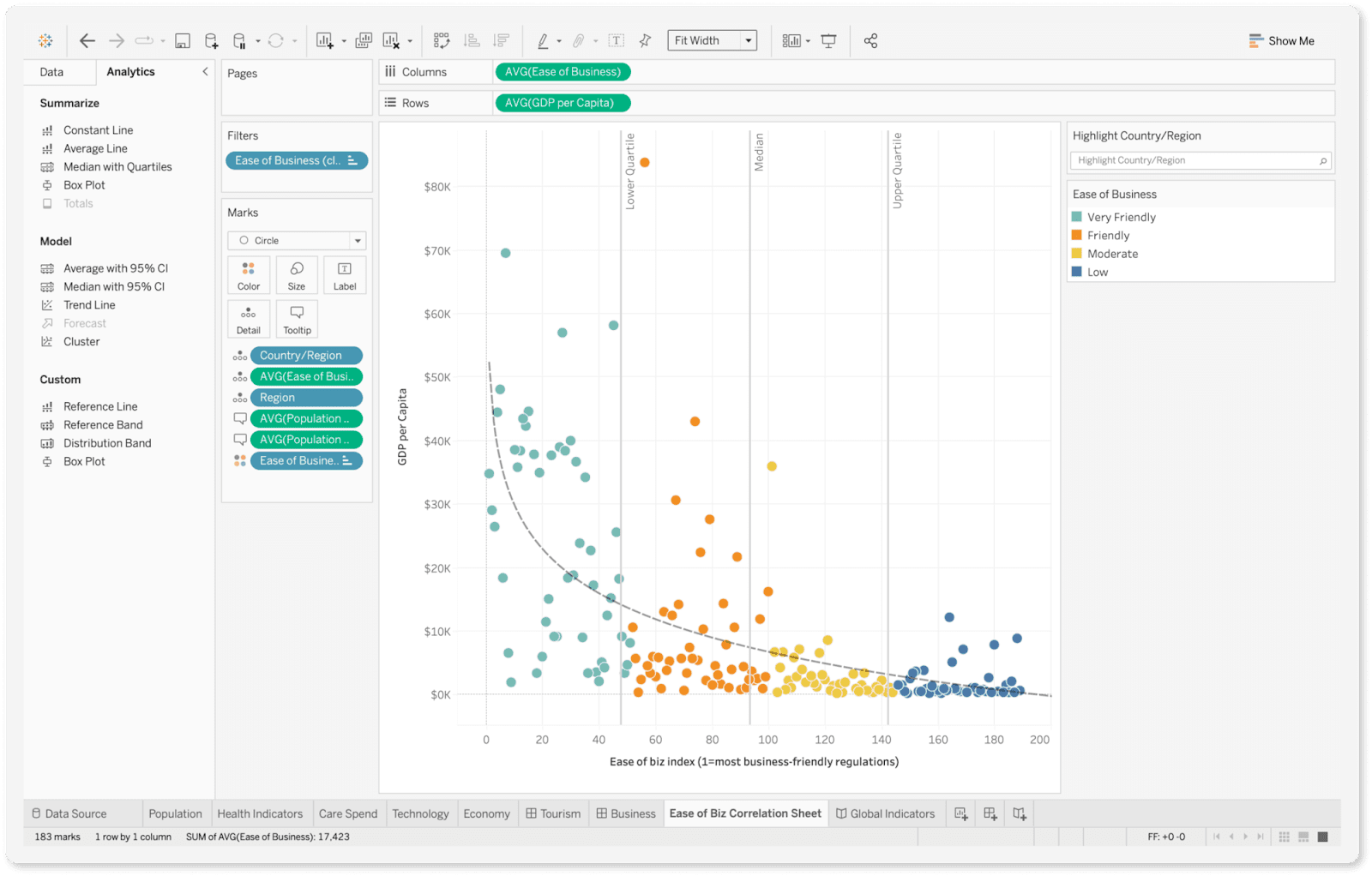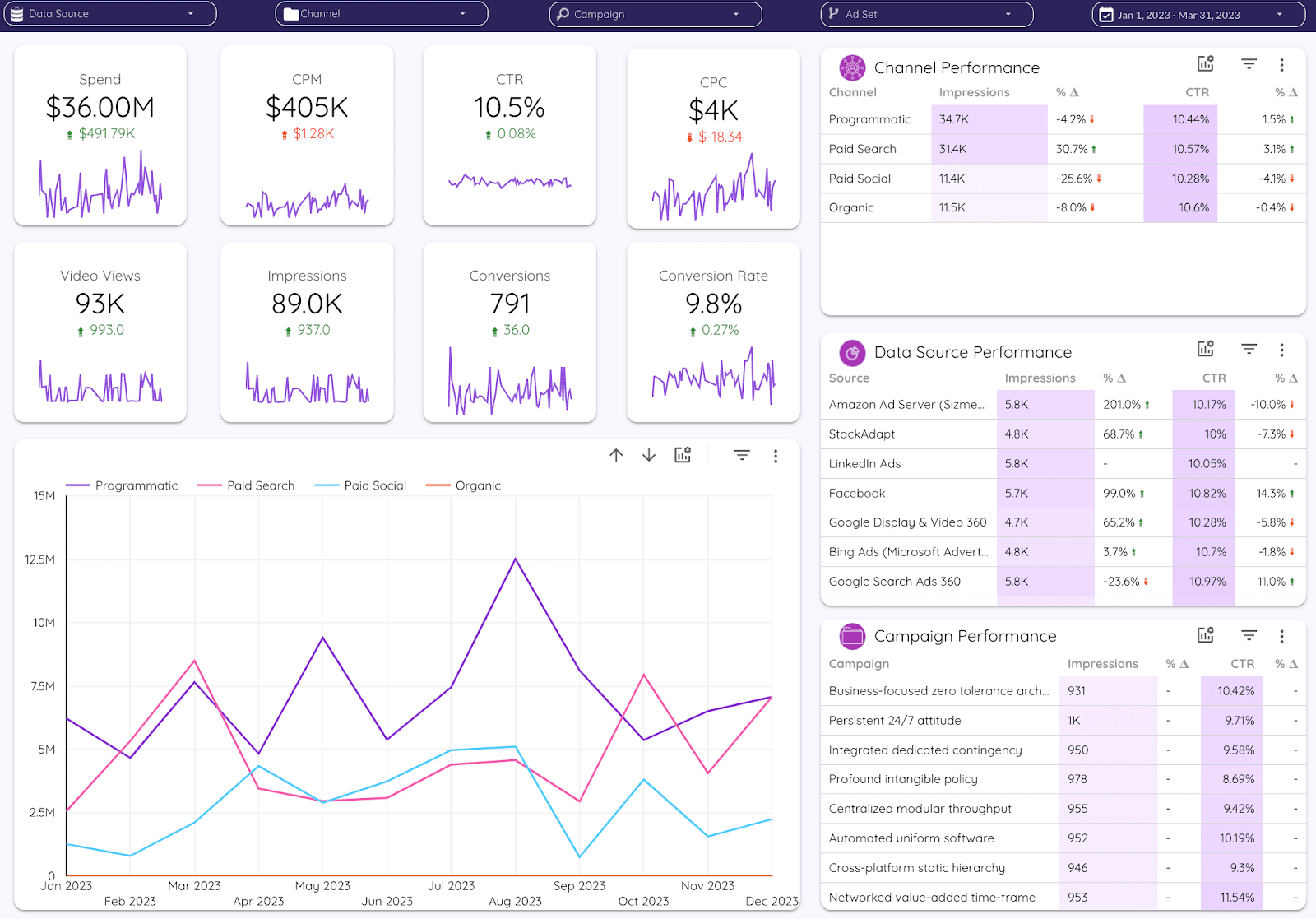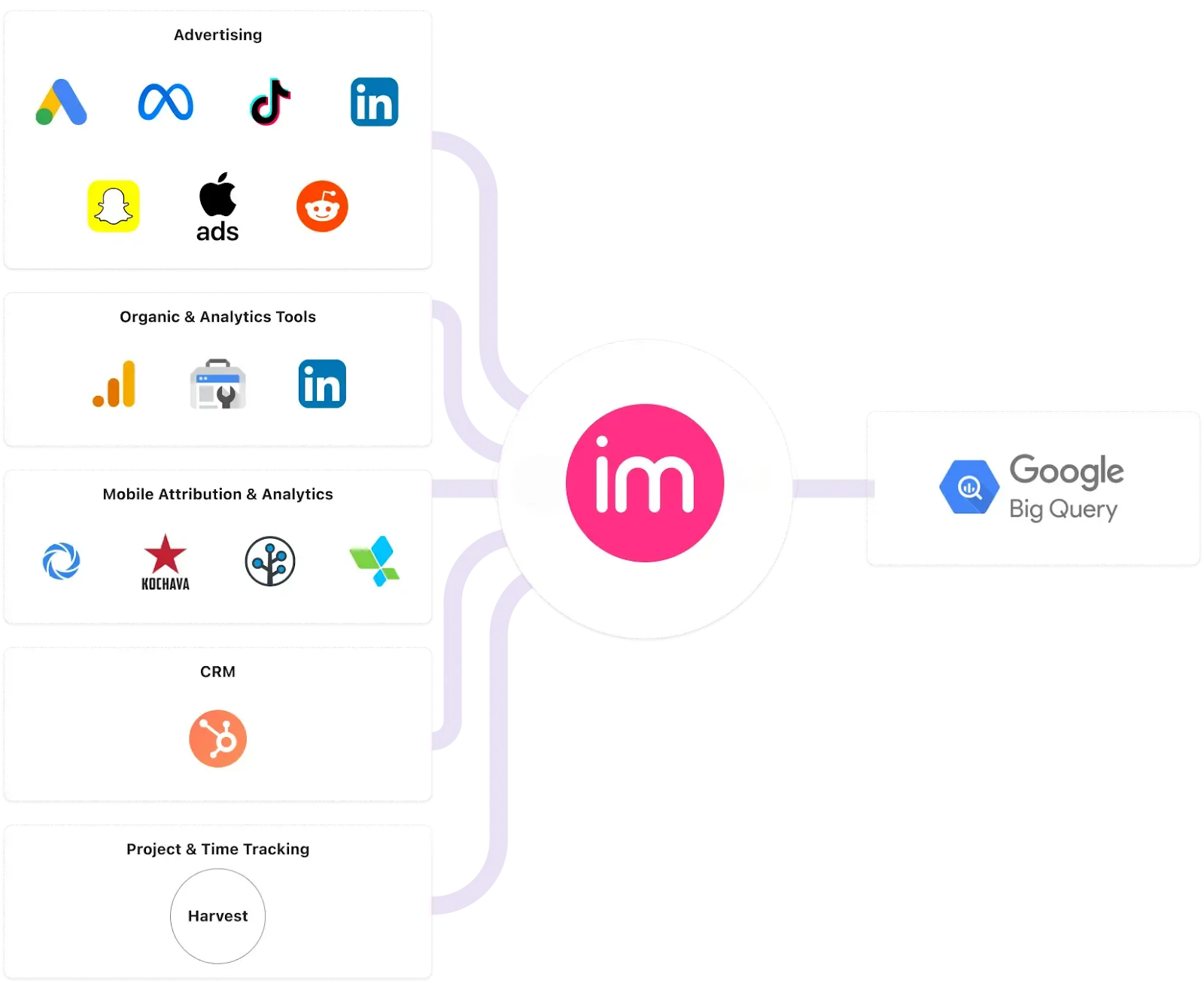I have dashboards, a data warehouse, and a team of analysts, does that mean I have marketing intelligence?
Not necessarily.
Without standardized metrics, automated data workflows, and a single, decision-ready view of performance, most teams are still stuck in reactive reporting.
In this guide, we break down what marketing intelligence is, how it differs from BI and marketing research, and what’s required to build a scalable, insight-driven marketing operation.
What Is Marketing Intelligence?
At the core of marketing intelligence is the concept of a single, consolidated view of marketing data. This single view eliminates discrepancies across tools, aligns all teams around the same metrics, and allows marketers to see how every marketing campaign, channel, and audience contributes to business outcomes.
A single source of truth solves many of the challenges that come with traditional reporting approaches like manual report consolidation, conflicting definitions, and the ongoing struggle to answer fundamental questions such as what’s driving the pipeline or where the budget should shift.
Beyond just consolidating data, marketing intelligence combines automation, data normalization, transformation logic, and performance monitoring into one system. It enforces consistent metric definitions (for example, what counts as a lead or a qualified opportunity), supports alerting and pacing, and ties marketing performance directly to business results.
Why Does Marketing Intelligence Matter?
Modern marketing environments are increasingly complex. Teams manage campaigns across a growing number of channels, often using tools that don’t speak to one another.
Spreadsheets multiply. Dashboards disagree.
ROI calculations become approximations at best.
And as budgets tighten, leaders are asked to justify spend with greater precision, faster.

Marketing intelligence solves this by turning disconnected data into a unified decision-making layer.
It helps build consensus on performance, reduces reliance on manual reporting, and empowers marketing teams to spot risks and opportunities earlier in the funnel, before they show up in missed KPIs or post-campaign analysis.
Types of Marketing Intelligence
Marketing intelligence isn’t a single function. It includes multiple categories, each having distinct use cases across operational execution and strategic planning.
While not every team needs to prioritize every type at once, knowing which types of marketing intelligence exist and what problems they solve helps identify gaps in current workflows and prioritize what matters most for performance, planning, and accountability.
Here are the key types of marketing intelligence most relevant to modern marketing teams:
- Performance intelligence: This focuses on tracking core marketing metrics (e.g., ad spend, conversions, ROI, CAC, and ROAS) across platforms and campaigns. It enables real-time performance monitoring, cross-channel comparisons, and consistent KPI tracking. For teams running high-volume campaigns, this is the foundation for optimizing spend and execution.
- Customer intelligence: Focuses on understanding customer behavior, preferences, and lifecycle patterns using first-party data from CRMs, web analytics, support platforms, and more. It helps teams tailor messaging, improve retention strategies, and prioritize high-value segments.
- Product intelligence: Gathers feedback, usage data, and feature engagement signals to inform product marketing and go-to-market strategy. It helps marketing align messaging with actual product value, understand adoption barriers, and collaborate more effectively with product teams.
- Competitor intelligence: These types help marketing teams understand the broader environment, competitor’s strengths, how the market is evolving, and where new opportunities may exist. It’s used to benchmark performance, refine messaging, and guide positioning decisions.
- Market intelligence or market understanding: Provides a macro-level view of market trends, customer needs, regulatory shifts, and emerging technologies. It helps organizations assess demand, identify market opportunities, and uncover whitespace opportunities. It’s typically used to guide strategic positioning, product marketing, and long-term investment.
Some sources also identify additional categories of marketing intelligence like brand intelligence, channel intelligence, content intelligence, and others. While these can provide value in certain contexts, let’s focus on the core types most critical for building a centralized, scalable, and decision-ready data foundation.
What Marketing Intelligence Is Not
When evaluating how to improve data-driven decision-making, many marketing teams explore marketing intelligence alongside other practices like business intelligence or marketing research.
In some cases, teams assume they already have marketing intelligence in place, when in reality, they're using BI tools for custom dashboards or relying on one-off research studies to guide business strategy.
But marketing intelligence serves a different role: it's designed to operationalize marketing data, automate insights, and support day-to-day performance management.
That’s why below, we break down how marketing intelligence differs from both business intelligence and marketing research.
Business intelligence vs. Marketing intelligence

Business intelligence (BI) systems are designed to support company-wide reporting across departments like finance, sales, and operations. They centralize data and help analysts create dashboards. BI tools are typically owned by centralized data teams and often require technical skills to manage and query.

Marketing intelligence, by contrast, is purpose-built for the marketing function. It focuses specifically on extracting, normalizing, and analyzing data from marketing platforms to support campaign monitoring, attribution, and ROI analysis. Unlike BI, which assumes clean, pre-modeled data, marketing intelligence solves the messy, day-to-day problems of fragmented marketing data. It enables marketers to make faster decisions without waiting on custom dashboards or manual data prep.
Marketing intelligence vs. Marketing research
Marketing intelligence and marketing research are often mistakenly used interchangeably, but they serve fundamentally different functions in how organizations gather and apply data.
| Aspect | Marketing Intelligence | Marketing Research |
|---|---|---|
| Primary purpose | Operational decision-making and performance monitoring | Strategic planning and audience insight |
| Data source | Live data from internal systems (ads, CRM, analytics, etc.) | Collected data via surveys, interviews, focus groups |
| Frequency | Ongoing, real-time or near real-time | Periodic, based on specific research initiatives |
| Use cases | Campaign tracking, ROI analysis, budget pacing, attribution | Message testing, customer needs assessment, target market exploration |
| Users | Marketing ops, analysts, performance marketers | Brand teams, product marketers, strategists |
| Output | Dashboards, real-time alerts, automated reports | Research reports, presentation decks, audience summaries |
| Tools involved | Marketing intelligence platforms, BI tools, data pipelines | Survey platforms, research agencies, panel tools |
Marketing research is project-based, static, and often qualitative. It typically involves collecting new data through surveys, interviews, focus groups, or observational studies.
The goal is to answer specific strategic questions, such as testing new messaging, assessing customer needs, evaluating brand perception, or exploring new market segments.
Marketing research is commonly used in campaign planning, product development, and brand strategy. The insights are based on sampled responses and are generally collected periodically, not continuously.
Marketing intelligence, by contrast, is continuous, operational, and rooted in live behavioral and performance data. It pulls from systems already in use, ad platforms, CRMs, web analytics tools, and marketing automation platforms.
Rather than asking people what they think, marketing intelligence shows what they do: which campaigns they engage with, where they convert or drop off, how much they cost to acquire, and how they progress through the funnel. It’s designed to monitor campaign health, budget pacing, attribution, and ROI across all active channels in near real-time.
How to Collect Marketing Intelligence: Methods & Sources
Let’s move from what marketing intelligence is to the actual practices, platforms, and techniques it encompasses.
Understanding how marketing intelligence is collected is essential for evaluating where your current workflows fall short and where to focus improvements.
Below are the core methods and sources used to build an effective marketing intelligence system.
1. Automated data integration
A strong marketing intelligence practice means tapping into both internal and external data streams. It's an enormous amount of information that must be collected, stored, and prepared for analysis.
That's why the foundation of any intelligence is extracting data from all relevant sources, including paid and social media platforms (Google Ads, Meta, LinkedIn), web and app analytics (GA4, Adobe Analytics), CRM and sales platforms (Salesforce, HubSpot), and lifecycle tools (Marketo, Braze).

This is typically handled by ELT platforms or marketing-specific data connectors that automate ingestion on a scheduled basis, be it hourly or daily.
2. Cross-platform data normalization
Raw data from marketing platforms varies significantly in structure, naming conventions, and metric definitions. Data normalization standardizes dimensions across sources, such as campaign naming, channel classifications, currency formats, and funnel stages.
This step is where foundational metrics (CPC, CPA, ROAS, etc.) are unified and custom taxonomies are enforced (for example, mapping “Facebook” and “Meta Ads” to the same channel).
Without normalization, performance reporting becomes fragmented, attribution is inconsistent, and comparisons across platforms are unreliable.
Normalization can be handled via:
- Custom transformation logic in dbt or SQL,
- Pre-built templates in marketing intelligence platforms,
- Harmonization rules embedded in the data pipeline.
3. Centralized storage and modeling
Once data is normalized, it’s routed to a centralized destination, most commonly a cloud data warehouse like Snowflake, BigQuery, Redshift, or Databricks.
This allows the marketing team and other stakeholders to query and analyze all data in one place. This step ensures the data is not just accessible, but aligned with how the business thinks about performance.
4. Operational monitoring and governance
Even with centralized and well-modeled data, marketing intelligence is only as good as the quality and reliability of the data.
Operational monitoring ensures that pipelines, naming conventions, and platform syncs are functioning correctly, so the data powering decisions is trustworthy and up to date.
This layer tracks practical issues that often disrupt reporting, such as:
- Budget pacing drift, where campaigns overspend or underspend relative to plan,
- Broken or delayed syncs from platforms like Meta, Google Ads, or HubSpot,
- Naming convention mismatches, which can prevent campaigns from being categorized correctly,
- Granularity issues, such as different attribution windows or inconsistent timestamp formats across platforms.
To manage this, many teams implement automated rule engines and alert systems that detect data gaps, schema changes, or metric anomalies before they impact dashboards.
5. Intelligence delivery
The final step is delivering marketing insights to decision-makers in formats they can use. This includes:
- Role-based dashboards, such as daily media pacing for buyers and ROI tracking for leadership,
- Scheduled reports or email digests,
- Alerts triggered by threshold changes, for example, CPC spike and lead volume drop,
- Embedded reporting inside CRM or campaign management platforms.
Delivery happens through tools like Tableau, Power BI, Looker, or purpose-built layers within enterprise analytics platforms. The focus is reducing time-to-insight, enabling self-serve access, and aligning metrics across stakeholders.
Marketing Intelligence Maturity Curve: What’s Next?
Achieving robust marketing intelligence is a journey of maturity. Most organizations progress through a maturity curve that can be described in stages, from ad-hoc spreadsheet reporting up to a fully integrated, intelligence-driven operation.
Stage 1: Spreadsheet-driven marketing
At the early stage, marketing data is handled in a very manual, fragmented way. Different channels and teams have their own reports and spreadsheets. There is no single source of truth, and data is used only on an ad-hoc basis.
An indicative sign of Stage 1 is when reports take so long to produce that they’re always looking weeks back.
The goal at this point is to start automating data collection and reporting, even in small ways, to reduce manual work.
Stage 2: Unified data and dashboarding
At this stage, organizations are committed to centralizing marketing data and using it regularly, not just for ad-hoc analysis.
Stage 2 is all about improving data visibility and accessibility. A common sentiment here is, "we need better dashboards."
However, it gradually becomes clear that dashboards alone aren’t enough.
To get real value, companies must also establish strong data governance and maintain consistent definitions. Otherwise, dashboards can end up amplifying data inconsistencies. And while dashboards offer a high-level view, they often show what is happening, not why.
Many organizations stall at this stage, but the real transformative benefits emerge as they move further up the curve.
Stage 3: Single source of truth and advanced analytics
Reaching Stage 3 means marketing data practices are far more systematic and integrated. The organization has established a single source of truth, unlocking new possibilities for advanced intelligence.
Modern analytics techniques and tools, often powered by artificial intelligence, come into play to mine the data for patterns, opportunities, and anomalies. For example, at this stage, a company might integrate marketing AI Agents that allow data exploration through plain-language conversations.
Stage 3 organizations become far more proactive. They no longer have to wait for quarterly reports to discover that a certain channel is underperforming, the system flags it in near real time.
Stage 4: Predictive and automated intelligence
In Stage 4, organizations go beyond analyzing historical data and start using data to predict future outcomes and automate decision-making.
Predictive models are layered onto historical and real-time data to anticipate trends like future pipeline gaps, campaign fatigue, or shifts in cost-per-acquisition. Early warning systems become more sophisticated, moving beyond simple alerts toward forecasting, budget reallocation recommendations, and customer churn risk scoring.
Stage 5: Prescriptive intelligence
At Stage 5, marketing intelligence fully evolves into prescriptive intelligence, models that not only predict outcomes but also recommend specific actions.
Marketing teams use systems that automatically suggest budget reallocations, optimize audience targeting based on predicted behaviors, and prioritize campaigns tied to the highest revenue potential.
A defining trait of Stage 5 is that marketing becomes a predictable, quantifiable revenue engine. Strategic decisions about product launches, regional expansions, or audience investments are directly tied to marketing intelligence outputs, with clear financial projections backing each move.
Key Takeaways
In the end, here's what you should remember about marketing intelligence and how to make your first steps towards it:
- The ultimate goal is not more data—it’s better decisions. Marketing intelligence aligns marketing, product, customer success, and sales teams around trusted metrics and accelerates optimization.
- Effective marketing intelligence requires more than dashboards. It includes automated data integration, cross-platform normalization, centralized modeling, governance rules, and tailored insight delivery.
- Tooling matters. Platforms like Improvado, Snowflake, and dbt help automate data workflows, enforce consistency, and reduce the manual overhead of preparing data for reporting.
- Mature marketing intelligence evolves in stages. Evaluate where you are and see what next steps you need to take.
If you're exploring how to build a more scalable, accurate, and insight-driven marketing data workflow, Improvado can help.
As a purpose-built marketing intelligence platform, it centralizes data from all your sources, enforces consistency, and delivers decision-ready insights without the need for constant engineering support. To see how it can support your team’s goals, book a demo with Improvado today.
.png)




.png)
